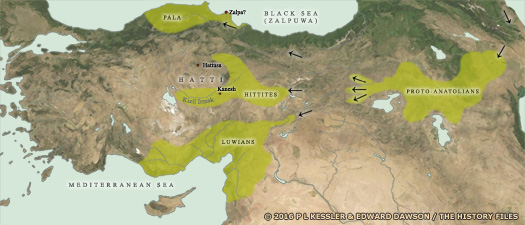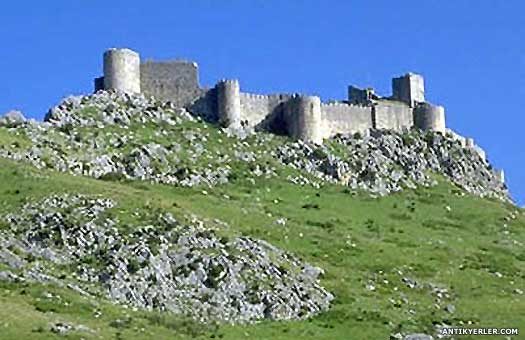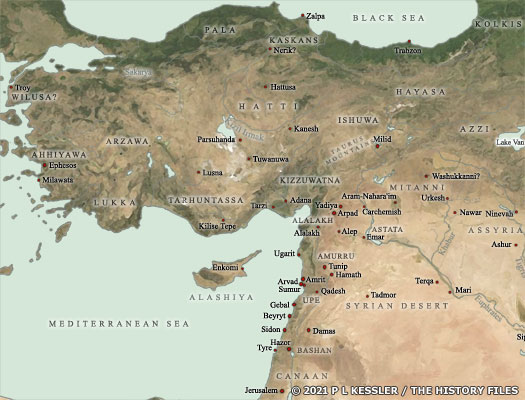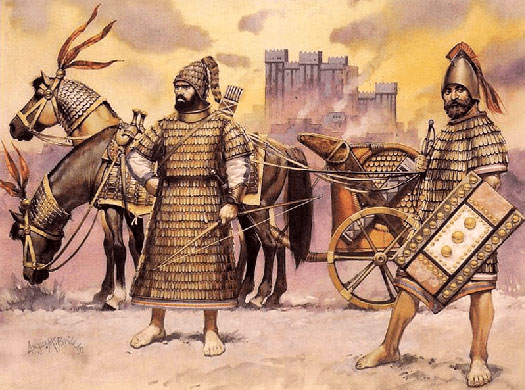
| LUWIAN Kizzuwatna / Kizzuwadna (Luwia) (South Indo-Europeans) :
This was a poorly attested state which was situated on south-eastern Anatolia's Cilician Plain, extending northwards into south-eastern Cappadocia beyond Comana in Cataonia. The area had been home to some of the earliest agricultural settlements, such as that at Çatal Hüyük, and was rich in cultivated fields and silver mines. Sargon of Akkad claimed to have reached the nearby Taurus Mountains in the twenty-fourth century BC, although this is unproven, and early Assyrian trade routes to Anatolia passed through the region.
Kizzuwatna emerged from the 'land of Adaniya' (modern Adana) near the coast during the dark age of the sixteenth century BC, and was dominated by a mixture of Indo-European East Luwian-speakers, Hittites from the north, and Hurrians from the east. The Luwian/Hittite language group which was part of the South Indo-European group seems to have been the first to begin a migration away from the original Indo-European homeland, to the north of the Black Sea and Caspian Sea. Its speakers, though, may not have entered the Mediterranean coastal region until the later centuries of the third millennium BC. The earliest Hittite records (begun well after both Luwian and the later Hittite settlement phases) refer both to Kizzuwatna and neighbouring Arzawa as Luwia, so it is possible that they emerged from a single territorial association (see feature link, right, for an examination of the origins of the Luwians).
Luwian, unlike Hittite, was not influenced by the indigenous Hattic speakers, suggesting that their settlements lay outside the influence of the Hatti city states. Other regional peoples, such as the Teucri, also included Luwian elements amongst their make-up, showing how far they spread. Although originally a Luwian creation over the course of roughly seven or eight hundred years of gradual settlement, it seems to have been Hurrian involvement that turned Kizzuwatna into a formalised state. A capital emerged at Kummanni, location uncertain but believed to be close to the first millennium BC settlement of Comana Cappadociae in southern central Anatolia (modern Turkey). The link is easy to make as a shift in pronunciation from 'Kummanni' to 'Comana' is acceptable. Kizzuwatna remained an independent power until the late fifteenth century BC, when it was conquered by Mitanni and then by the Hittites.
To contemporary Egyptians, the later state of Tarhuntassa was known as Kode or Qodi. It seems that this was inherited from the Egyptian name for Kizzuwatna itself, which was logical enough as Tarhuntassa would have formed the entire south-western arm of Kizzuwatna. By the early first millennium BC the same region was known as Kedi or Kode until the fall of the Assyrian empire at the end of the sixth century BC. It is unclear whether this 'foreign' name formed the basis of the name Khilikku which the Greeks mangled into Cilicia. More likely this was a direct descendant of 'Kizzuwatna' itself.
(Information by Peter Kessler, with additional information by Edward Dawson, from The Horse The Wheel and Language: How Bronze Age Riders from the Eurasian Steppes Shaped the Modern World, David W Anthony, from The Excavations at Korucutepe, Turkey, 1968-70: Preliminary Report. Part I: Architecture and General Finds, Maurits van Loon (Journal of Near Eastern Studies Vol 32, No 4, Oct, 1973, pp 357-423), from Hittite Diplomatic Texts, Gary Beckman (Second Ed, Scholars Press, Atlanta, 1999), from The Kingdom of the Hittites, Trevor Bryce (1998), from The Hittites, O R Gurney (1991), from Annals of Mursili (Years 1 to 8), Ian Russell Lowell, from The Hittites, J G Macqueen (1996), and from External Links: Indo-European Chronology - Countries and Peoples, and Indo-European Etymological Dictionary, J Pokorny, and The History of Kizzuwatna and the Date of the Šunaššura Treaty, Richard H Beal (Orientalia, Nova Series, Vol 55, No 4 (1986), pp 424-445, available via JSTOR).)
c.2300 BC :
Some time after this point, Luwian-speakers settle in southern Anatolia, to the south of the (probably indigenous) Hatti. The Luwians are Indo-Europeans of the South Indo-European group - generally agreed to have been the first group to migrate out of the original Indo-European homeland to the north of the Black Sea and Caspian Sea. The route they have taken in their migration is open to interpretation (and guesswork!), but a route through the Caucuses seems most likely, followed by a more easterly route around the eastern shores of the Caspian Sea.
Once in the region of north-eastern Anatolia they will have settled into a semi-nomadic existence for a couple of millennia, before migrating westwards during an intense dry spell into Anatolia itself and settling permanently from about 2300 BC onwards. Once there, the Luwians form two major regional states, Arzawa and Kizzuwatna (possibly a single state or region initially, which only later divides into two states).
This map attempts to illustrate in basic terms the separate paths taken by the Luwians, Hittites, and Pala during their westwards migration and their progress from proto-Anatolians to kingdom-builders It seems more than coincidental that 'barbarians from the north' are causing problems in cities within Syria such as Ebla at the same time as the Gutians are first mentioned. These are possible Indo-European tribes who inhabit the Zagros Mountains. In the same period, the Luwians are settling across southern Anatolia, making it likely that one of these groups is responsible for probing expeditions farther south. They could be testing the waters to see whether territory could be acquired there.
c.165 - 1620 BC :
Under Hattusili, heir to the Hittite throne of Kassura, the Hittites rapidly defeat their competitors in central Anatolia. This is followed up by the attack and destruction of several vassals of the Syrian state of Yamkhad over a span of several years, extending their own domains south into Syria to include Carchemish amongst others, while in Amurru a local king is allowed to govern as a vassal. Ebla is also destroyed, either by Hattusili or his son, while apparent early dominance over Kizzuwatna may also date from this period.
c.1600 BC :
Hurrians begin migrating into Kizzuwatna from Urkesh and Nawar in this period, settling in the coastal region of Adaniya. The state of Kizzuwatna emerges from the 'land of Adaniya' (modern Adana) near the coast during the dark age of this period. Its general population may predominantly be Luwian, but it seems that Hurrians integrate themselves into that population on an equal basis rather than forming a new ruling elite.
Yilanlikale, more colourfully known as Snake Castle, is east of Misis, on the steep southern bank of the Ceyha, and is home to this Armenian stronghold and Crusader castle, but the terrain offered similar defensive qualities to the Kizzuwatnans fl c.1540s BC :
Pariyawatri : Ruled? Involved in revolt against Hittite King Ammuna?
fl c.1510s BC:
Ishputakhshu / Ishputashu / Išputahšu : Son. Suzerain of Tarsus area. (New low chronology dating.)
late 16th cent BC :
Kizzuwatna occupies a wide oval of territory between the Hittites to the north and west, and the increasingly powerful state of Mitanni to the south and east. Under the leadership of Išputahšu (who bares a Hittite name rather than a Luwian one) the state concludes a treaty with the weakened Hittites (with King Telipinu, although some sources say Tudhaliya II (I) which, with the dating used here, places that king at least fifty years later than this event). Kizzuwatnan pottery around this time is fairly primitive but, by the end of the fifteenth century BC or so, it has spread to the neighbouring Ishuwan folk to dominate there too.
fl c.1500 BC :
Eheya : Tied in with Hittite Tahurwaili, he may have ruled
Paddatisu / Paddatišu : Known only from a treaty with an unknown Hittite king.
c.1490 BC :
Paddatisu renews a treaty of peace with Hittite king Hantili II, having previously agreed the same treaty with the Hittite king's predecessor, Alluwamna. The Hittites are enduring a period of some difficulty at the moment, not strong enough to be externally dominant, while Kizzuwatna is virtually on a par in terms of organisation and influence.
fl c.1470s BC :
Pilliya / Pelliya : Signed treaty with Idrimi of Alakhtum.
c.1480 - 1475 BC :
Although relations with the weakened Hittite king, Zidanta II, are initially rocky, with both kingdoms grabbing territory from each other, a new parity treaty is agreed between Zidanta and Pilliya - the last between the two states.
A short dark age followed the Hittite collapse and the creation of power vacuums in Babylonia and Syria (caused by the Hittites) during the sixteenth century BC c.1470 BC :
Kizzuwatna is in a weaker position in terms of relations with the expanding state of Alakhtum. Pillya has to sign a treaty with its powerful ruler, Idrimi, shortly before the increasingly powerful Mitanni state (under Paratarna, although the sequence of rule in early Mitanni is confused) conquers Kizzuwatna. With the state of Ishuwa existing on Kizzuwatna's north-eastern border, the cities of northern Syria are therefore rendered inaccessible to the Hittite armies, except through the south-eastern Taurus passes.
unassura / Syunassura / Šunaššura I : Existence debatable. Posited from a Hittite treaty.
fl c.1460 BC :
Talzu / Talzush : Contemporary with Hittite Huzziya II.
fl c.1430 - 1400 BC :
Sunassura / Syunassura / Šunaššura II : Hittite vassal by c.1400 BC. Last king.
c.1430 BC :
Although Ishuwa is defeated by the Hittite king, Tudhaliya II (I), that state sides with Mitanni. Tudhaliya is unable to effect a conquest of Ishuwa, so he successfully attacks Kizzuwatna instead.
c.1400 BC :
Sunassura
is a contemporary of the Hittite king, Tudhaliya II (I), and then
his successor, Arnuwanda I. Allegiance is shifted back to the
Hittites in this period, as the state becomes a battleground between
them and Mitanni, but Arnuwanda overruns and conquers the state,
making Sunassura a vassal.
c.1392 BC :
The Hittites wrest control of the Assyrians from Mitanni, possibly annexing the territory to Kizzuwatna along with the Mitanni capital, which appears to fall briefly into Hittite hands. Governors are placed in charge of Kizzuwatna after Sunassura's reign ends.
Mitanni warriors are shown here dressed in a typical northern Mesopotamian costume which they most likely picked up following their arrival in the region in the 1600s BC fl c.1390s? BC :
Kantuzili : Hittite prince and possible (but uncertain) vassal governor.
c.1370 BC :
Kizzuwatna
rebels against Hittite rule under the reign of Suppiluliuma I,
attempting to secede to Mitanni. Perhaps initially the revolt
proves to be successful, as Kizzuwatna has to be re-conquered
by the Hittites. Either before or after this, and relatively early
in his reign, Suppiluliuma places one of his sons, Telipinu, as
'priest of Kizzuwatna'. This is no ordinary priestly role, however.
Telipinu's duties are virtually those of a governor or sub-king
of a vassal state.
fl c.1370s? BC :
Telipinu / Telepinush : Son of Hittite Suppiluliuma. Vassal governor of Kizzuwatna.
c.1360s BC :
Once Suppiluliuma has reorganised Hittite control of northern Syria, Hittite princes are placed on the throne of Alep as regional representatives of the empire. Either this is not a permanent arrangement or there are gaps in the record, but the first of them is Telipinu. No further 'priests' of Kizzuwatna are known, suggesting either a lack of records or a shift to more normal control by a regional governor.
c.1300/1286 BC :
The state supplies troops to various Hittite armies, including the one which now fights against Egypt at the battle of Kadesh/Qadesh. At some point in the late Hittite period, a people called the Danuna settle in Adaniya (with a possible relation to the Danya). This should be taken as a sign of the beginnings of the turmoil that will grip the Near East in the thirteenth century BC.
c.1275 BC :
Pudu-Hepa (Pudu?epa), formerly a Kizzuwatnan priestess, becomes Hittite Hattusili III's queen upon his accession. A highly influential figure of her time, she aids the integration of the Kizzuwatnan pantheon into the Hittite equivalent, with the goddess Hebat becoming very important.
Puda-Hepa, Hattusili III's queen (on the right), proved highly influential in bringing Kizzuwatnan culture into the Hittite court in the thirteenth century BC - only for everything the two of them held dear to be swept away within two generations of their reign c.1200 BC :
Decaying
from late in the thirteenth century BC, as Assyria rises and instability
grips the Mediterranean coast, the Hittite empire is looted and
destroyed by various surrounding peoples, including the Kaskans
and the Sea Peoples (and perhaps even selectively by its own populace).
Following the fall of the Hittite empire, the region appears to fragment to an extent, being settled in parts by Greeks from Pamphylia, while other areas come under the control of neo-Hittite states. Eventually, by the ninth century BC, the Kizzuwatnan city of Hattina is occupied by Aramaeans to form a small state. By the eighth century BC, two kingdoms emerge in the west of former Kizzuwatna: Que and Khilikku, while Gurgum and Kummukhi emerge in the eastern section, and Tabal exists to the north.
Source :
https://www.historyfiles.co.uk/ |




